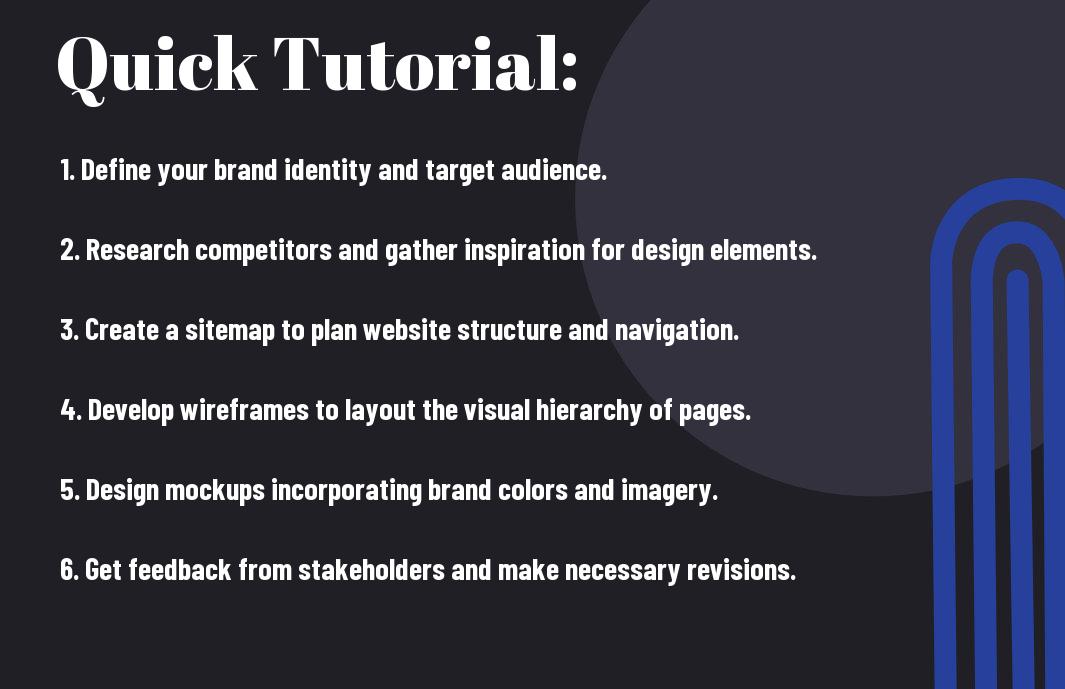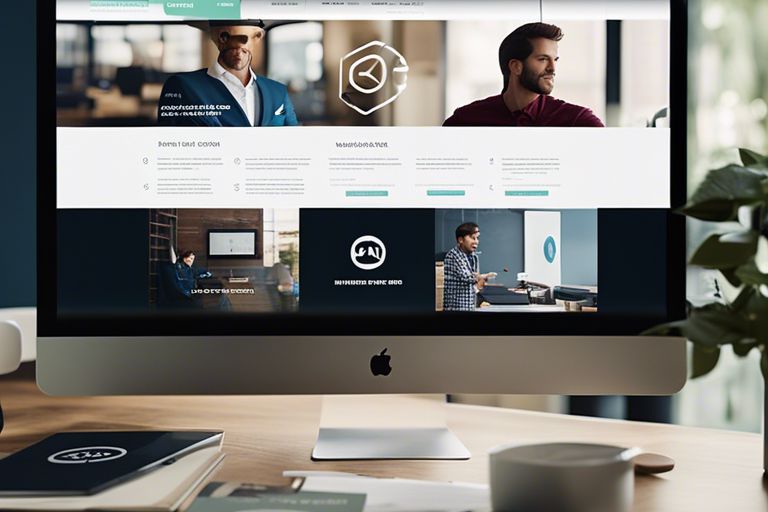10 Steps To Creating A Custom Website Design For Your Small Business

The Importance Of Social Media Integration In Modern Website Design
March 28, 2024
The Importance Of Social Media Integration In Modern Website Design
April 1, 2024Embark on a journey toward a stunning online presence with our comprehensive guide on crafting a unique and professional website design for your small business. In today’s digital age, having a customized website is no longer a luxury but a necessity. Learn the vital steps to take your business’s online representation to the next level, attracting more customers and boosting your brand’s credibility. From defining your goals and target audience to implementing eye-catching visuals and responsive layouts, these crucial steps will help you stand out in the competitive online market. Don’t miss out on the opportunity to create a tailored website design that truly reflects the essence of your business.
Key Takeaways:
- Understanding your brand: Before starting the design process, it is crucial to have a clear understanding of your brand identity, values, and target audience.
- Planning and research: Take the time to research your industry, competitors, and target market to create a website design that sets you apart and resonates with your audience.
- User experience and functionality: Focus on creating a user-friendly website with easy navigation, clear call-to-actions, and responsive design to enhance the overall user experience.

Define Goals
Brand Objectives
For a successful custom website design, it is crucial to start by defining your brand objectives. These goals will shape the look and feel of your website, ensuring that it aligns with your brand identity and messaging. Consider what image you want to portray to your audience and how you want your brand to be perceived. Whether it’s to increase brand awareness, drive sales, or establish credibility, clearly defining your brand objectives is the first step towards a successful website design.
Target Audience
With clearly defined brand objectives in place, the next step is to identify your target audience. Understanding your target demographic will help you tailor the design and content of your website to cater to their needs and preferences. Consider factors such as age, gender, interests, and online behavior to create a user-friendly experience that resonates with your target audience.
Any successful website design considers the target audience’s demographics, preferences, and behavior to ensure the website effectively engages and connects with visitors. By aligning your design with the needs and expectations of your target audience, you can create a custom website that drives conversions and builds brand loyalty.
Choose Platform
Research options
Even before starting the design process, it is crucial to carefully research the different website platforms available. From popular options like WordPress and Wix to more specialized platforms like Shopify and Squarespace, each platform offers unique features and functionalities. One should consider factors such as ease of use, customization options, and integrations with other tools when evaluating these options.
Evaluate scalability
Even with a small business website, scalability is crucial for future growth. Choose a platform that can accommodate your business as it grows, allowing for easy expansion of features and content. A platform that is too limited can hinder your website’s ability to adapt to the changing needs of your business. A platform that offers room for growth and scalability will ensure your website remains relevant and effective in the long run.
Plan Layout
Sketch wireframes
Now is the time to sketch the wireframes for your website design. This step involves creating a basic layout of your website’s structure, including where various elements will be placed. Sketching wireframes allows you to visualize the flow of information on your site and ensure that it is easy to navigate for users.
User experience focus
An important aspect of creating a custom website design is to focus on user experience. This means designing your site in a way that ensures users can easily find the information they are looking for and navigate the site with ease. By prioritizing user experience, you can increase the chances of visitors staying on your site longer and converting into customers.
Experience
Experience shows that websites with a strong user experience design are more likely to rank higher in search engine results and have lower bounce rates. By focusing on user experience during the design process, you are not only making it easier for visitors to navigate your site but also improving your overall online presence and brand image.

Select Color Scheme
Brand colors
Your brand colors play a crucial role in creating a memorable and recognizable identity for your small business. Choose a color scheme that reflects your brand personality and resonates with your target audience. Consistency is key, so ensure that your brand colors are used across all marketing materials, website elements, and communication channels.
Visual psychology
SchemeAccording to visual psychology, colors can evoke specific emotions and perceptions in viewers. When choosing a color scheme for your website design, consider the psychological impact of different colors on your audience. For example, blue is often associated with trust and professionalism, while red can create a sense of urgency or excitement. Understanding the psychological effects of colors can help you create a website design that effectively communicates your brand message and influence visitor behavior.
Selecting the right color scheme is a crucial decision in website design as colors can influence how your brand is perceived by visitors. Visual psychology can help you understand the impact of different colors on human emotions and behavior, allowing you to strategically use colors to convey your brand message and enhance the user experience. By selecting brand colors that align with your brand identity and leveraging visual psychology principles, you can create a custom website design that resonates with your target audience and leaves a lasting impression.
Design Navigation
Intuitive Structure
Not sure where to start when designing the navigation for your custom website? Consider the importance of intuitive structure. Your website’s navigation should be easily understandable for visitors, allowing them to find what they need quickly and efficiently. Keep it simple and straightforward, organizing your pages in a logical order that makes sense for your business and customers.
Mobile Responsiveness
On the go, mobile devices are increasingly becoming the primary way people access the internet. You’ll want to ensure your custom website design is mobile-responsive to provide users with the best experience regardless of the device they are using. This means that your website will adapt and look great on smartphones, tablets, and other mobile devices, ensuring consistent accessibility for your audience.
It’s important to prioritize mobile responsiveness because search engines like Google now use mobile-first indexing, meaning they primarily use the mobile version of a site’s content to rank pages. By neglecting mobile responsiveness, you could be missing out on potential traffic and revenue.

Create Content
Engaging Copy
If you want your small business website to stand out, compelling and engaging copy is crucial. Despite the design being visually appealing, it’s the words on the site that will ultimately convert visitors into customers. Engaging copy should be concise, relevant, and tailored to your target audience. It should communicate your brand’s message effectively and entice visitors to take action, whether it’s making a purchase, signing up for a newsletter, or contacting you for more information.
Multimedia Elements
If you want to create a truly engaging and dynamic website for your small business, incorporating multimedia elements is key. An effective use of images, videos, infographics, and other visual elements can enhance the user experience, make your content more shareable, and help convey your brand’s story in a more visually compelling way. Including multimedia elements also helps break up the text and keeps visitors more engaged and interested in your content.
In terms of multimedia elements, copy should complement the visuals and vice versa. Make sure your written content is aligned with the tone and style of your images and videos to provide a cohesive and engaging user experience.
Incorporate Branding
Logo Placement
Now, when it comes to incorporating your branding into your custom website design, logo placement is key. Your logo is the visual representation of your brand, so it should be placed prominently on your website. It should be visible on every page of your site, typically in the top left corner or center to ensure that visitors can easily identify your brand.
Consistent Messaging
If you want to establish a strong brand presence, consistent messaging across your website is crucial. Your brand’s voice, tone, and message should be uniform throughout your site to create a cohesive and memorable experience for visitors. Consistency in messaging helps build trust and brand recognition among your target audience.
Placement of your logo and consistency in your messaging are two key elements in successfully incorporating your branding into your custom website design. By ensuring that your logo is prominently displayed and maintaining a consistent message throughout your site, you can strengthen your brand identity and make a lasting impression on visitors.
Test Functionality
Now, it’s time to ensure that your custom website design functions perfectly across different devices and browsers. For a comprehensive guide on creating a small business website, check out 10 Easy Steps To Create The Best Small Business Website.
Debug issues
Clearly, testing for any issues or bugs is crucial before launching your website. Make sure all links work correctly, forms are submitting data properly, images are loading efficiently, and all functionalities are functioning as intended. If you encounter any issues, debug them promptly to provide a seamless user experience.
Cross-browser checks
If you want your website to reach the widest audience possible, it is vital to perform cross-browser checks.If any discrepancies are found, it could lead to inconsistent user experiences or malfunctions on certain browsers. Ensure that your website looks and works perfectly on popular browsers such as Google Chrome, Safari, Firefox, and Microsoft Edge.

Launch Website
Announce online
Now that your custom website design is live, it’s time to spread the word. Announce the launch of your website on your social media platforms, email newsletters, and any other online channels you use to reach your audience. Encourage your followers to visit the site, explore its features, and provide feedback. This will help generate buzz and drive traffic to your new online home.
Monitor performance
On an ongoing basis, it’s crucial to monitor the performance of your website to ensure it’s meeting your business goals. Track metrics such as website traffic, conversion rates, and user engagement to identify areas for improvement and optimization. Use tools like Google Analytics to gain insights into how visitors are interacting with your site and make data-driven decisions to enhance its performance.
To wrap up
Drawing together the insights gained from the 10 steps outlined in this guide, creating a custom website design for your small business involves careful planning, research, and execution. By following these steps, you can develop a website that effectively represents your brand, appeals to your target audience, and helps you achieve your business goals. If you want to dive deeper into the initial stage of creating a website strategy, check out 10 Steps to Create a Website Strategy. Be mindful of, a well-designed website is a valuable asset that can set your business apart in the digital landscape.
FAQ
Q: Why is custom website design important for small businesses?
A: Custom website design allows small businesses to stand out from competitors, establish a unique brand identity, and cater to specific target audiences effectively.
Q: What are the benefits of creating a custom website design for a small business?
A: The benefits of a custom website design include improved user experience, increased credibility, higher search engine rankings, better conversion rates, and scalability for future growth.
Q: How can small businesses start the process of creating a custom website design?
A: Small businesses can start the process by defining their brand identity, setting clear goals and objectives for the website, researching their target market, and hiring a professional web designer or agency.
Q: What are some key elements to consider in a custom website design for a small business?
A: Key elements to consider include responsive design for mobile devices, intuitive navigation, high-quality visual content, clear calls-to-action, fast loading speeds, and search engine optimization (SEO) best practices.
Q: How can small businesses maintain and update their custom website design over time?
A: Small businesses can maintain and update their custom website design by regularly monitoring website performance, analyzing user feedback, updating content and visuals, staying current with design trends and technologies, and investing in ongoing website maintenance services.


